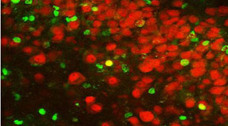Research in molecular and cellular neuroscience

What cellular mechanisms underlie memory and synaptic plasticity? Are they affected by brain disorders such as schizophrenia and Alzheimer's disease? The lab is interested in two brain structures — the hippocampus and the septum— which interact closely in order to generate critical aspects of learning and memory. There is growing evidence that important pathological changes in these brain structures may underlie cognitive deficits observed in schizophrenia and Alzheimer's disease.
The primary objective of Sylvain Williams, PhD, Laboratory is to understand how neurons interact within and between these structures, how they generate learning and memory in normal conditions, and how they are affected in disorders.
Using an integrated and multidisciplinary approach, including electrophysiology and molecular biology, the laboratory is studying:
- Changes in synaptic transmission and plasticity occurring in the hippocampus and septum in animal models relevant to schizophrenia.
- How synaptic interactions between septum neurons and hippocampus neurons may contribute to network activity and synaptic plasticity.
Funding
Canadian Institutes of Health Research (CIHR)
Natural Sciences and Engineering Research Council (NSERC)
Alzheimer Society of Canada
National Alliance for Research on Schizophrenia and Depression (NARSAD)
Research interests
Theses are some of the lab projects:
Changes in synaptic transmission relevant to schizophrenia
Funding: CIHR, NARSAD, NSERC
The lab is interested in determining changes in hippocampal neuronal circuits that underlie learning and memory deficits in schizophrenia. The lab uses two clinically relevant models of schizophrenia. The first model is that of maternal infection and schizophrenia. Maternal infection during critical periods of pregnancy has been associated with an increased incidence of schizophrenia in offspring. The lab mimics infection during pregnancy and examines hippocampal circuitry in the offspring. Interestingly, many significant alterations in hippocampal circuitry are observed in this model. An understanding of the subtle changes taking place in synaptic transmission will help determine how environmental factors alter neurodevelopment that leads to cognitive dysfunction in schizophrenia.
The second model (in collaboration with Lalit Srivastava, PhD) is a mouse strain that has a natural mutation for a gene named Dysbindin-1, one of a few genes known to be significantly associated with increased risk for schizophrenia. The gene product, dysbindin, is known to be reduced in the hippocampal region in schizophrenia. We believe that dysbindin may play a role in the release of the neurotransmitter glutamate. The goal is to determine the role of dysbindin in neurotransmitter release and synaptic plasticity, and how an alteration of this important protein contributes to memory loss observed in schizophrenia.
Electrophysiological and molecular analysis of newly-described glutamatergic septal neurons and their modulation of hippocampal activity
Funding: CIHR, NSERC
The septal area is known to extensively modulate hippocampal activity and help establish the necessary conditions for learning and memory. The septal area has intrigued scientists for years because of its important role in memory and because of its exceptional vulnerability in Alzheimer's disease. Historically, GABAergic and cholinergic neurons in the septum were thought to be the cell types modulating hippocampal activity. However, we have recently found a third type of neuron in the septum projecting to the hippocampus and using glutamate as a neurotransmitter. The lab is therefore investigating how these new septal glutamate neurons modulate hippocampal GABAergic and pyramidal neurons. The lab has developed a new complete in vitro preparation that preserves both the septum and hippocampus, and all the connections between these two structures, in order to establish the functional role of the glutamate neurons.
This study will offer a new perspective on septo-hippocampal interactions in health and disease.
Techniques
The lab uses a combination of electrophysiology (patch-clamp and field recordings), molecular biology and imaging techniques.
The lab has developed an important array of methods including single-cell RT-PCR, which can reveal several mRNA markers simultaneously in patch-clamp recorded neurons.
In addition to more common brain slices, it has also developed a complete in vitro preparation of the septum and hippocampus, which allows investigation of septo-hippocampal interactions in vitro.
In addition, the lab uses cell cultures such as septal neurons, grown on astrocytic islands, to investigate the mechanisms underlying neurotransmitter release and modulation from single neurons.
Finally, the lab also uses more common techniques such as immunohistochemistry and in situ hybridization in brain tissue to visualize protein and mRNA expression, respectively.
Sylvain Williams, PhD, Principal Investigator
Marc Danik, PhD, Associate Researcher
danmar_At_douglas_dot_mcgill_dot_ca
Research project: Role of co-transmission in septal neurons using molecular biology and immunocytochemistry, single-cell RT-PCR.
Frédéric Manseau, PhD, Post-Doctoral Fellow
frederic_dot_manseau_At_douglas_dot_mcgill_dot_ca
Research project: Determining septo-hippocampal interactions using electrophysiology, calcium imaging and molecular biology.
Romain Goutany, PhD, Post-Doctoral Fellow
Research project: Determining how septo-hippocampal network oscillations are altered in animal models of schizophrenia.
Germaine Lowe, MSc Student, Dept. of Neurology, McGill University
germaine_dot_lowe_At_douglas_dot_mcgill_dot_ca
Research project: Examination of hippocampal circuitry in a prenatal infection model of schizophrenia.
Carey Huh, MSc Student, Dept. of Neurology, McGill University
youlimh_At_hotmail_dot_com
Research project: Investigating the mechanism underlying the release of glutamate from newly-described septal glutamatergic neurons.


